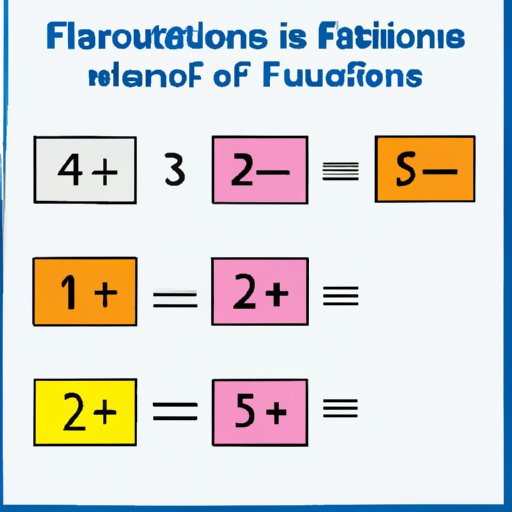Introduction
Fractions are essential mathematical tools that we encounter in everyday life. From splitting pizza slices between friends to measuring ingredients for a recipe, fractions serve as an essential tool for managing quantities. However, dealing with fractions can be challenging, especially when identifying their values and their relationships with other fractions. One common problem that leaves many people confused is determining which fraction is equal to another. This article aims to provide a comprehensive guide on understanding and solving this problem.
Fraction Identification: Solving the Mystery of Equivalent Fractions
Equivalent fractions are two or more fractions that have the same value, but not necessarily the same representation. For example, 1/2, 2/4, and 3/6 are equivalent fractions since they all represent the same amount of a whole.
Equivalent fractions are essential since they allow us to compare and add fractions with different denominators. By converting fractions to a common denominator, we can add or subtract them with ease. Additionally, equivalent fractions make it easier to simplify fractions and solve more complex fraction problems.
To identify whether two fractions are equivalent, you can cross-multiply the fractions and compare the products. If the products are equal, the fractions are equivalent. For example, to find out whether 1/2 and 6/12 are equal, we can multiply 1 x 12 and 2 x 6. The products are 12 and 12, respectively, showing that the two fractions are equivalent.
Equalizing Fractions: Discovering the Relationship Between Fractions
The basis of fractions is understanding them as parts of a whole. The denominator represents the total number of equal parts that make up the whole, while the numerator represents the number of parts we are trying to describe. For example, in the fraction 3/4, the whole is divided into four equal parts, and we are describing three of those parts.
When dealing with fractions with different denominators, it can be challenging to compare them to one another. To do this, we need to find a common denominator that the fractions share. This denominator is often the least common multiple of the two denominators. Once we have a common denominator, we can add or subtract the fractions with ease.
To convert fractions to equivalent fractions with like denominators, we can simply multiply them by the same number. For example, to convert 2/3 to a fraction with a denominator of 12, we can multiply both the numerator and denominator of 2/3 by 4, giving us 8/12. We can also convert 3/5 to a fraction with a denominator of 12 by multiplying both the numerator and denominator by 2, giving us 6/12.
Fractions in Harmony: Understanding Equivalent Fractions
Equivalent fractions are closely related to multiplication and division. To find equivalent fractions, we can multiply or divide both the numerator and the denominator by the same number. For example, to find an equivalent fraction to 2/3, we can multiply the numerator and the denominator by 2, giving us 4/6. Alternatively, we can divide the numerator and denominator by 3 to get 2/3 (2/3 ÷ 3/3 = 2/3).
Simplifying equivalent fractions is also simple using multiplication and division. To simplify fractions, we divide both the numerator and the denominator by their greatest common factor (GCF). The GCF represents the highest number that both the numerator and denominator can be divided by without a remainder. For example, to simplify 6/12, we can find the GCF of 6 and 12, which is 6. We divide both the numerator and denominator by 6, giving us 1/2.
Behind the Numbers: The Art of Identifying Equal Fractions
We can simplify fractions by factoring out common factors and then dividing them by their GCF. To factor out common factors, we can use prime factorization. For example, to simplify 24/36, we can first find the prime factors of both numbers. 24 = 2 x 2 x 2 x 3, and 36 = 2 x 2 x 3 x 3. We then cancel out the common factors, leaving us with 1 x 1 x 2 x 3 over 2 x 3 x 3 x 1. We can then divide both the numerator and the denominator by 6 (GCF), giving us 1/3.
The GCF helps us identify equivalent fractions by finding the largest number that divides into both the numerator and denominator. For example, if we have the fraction 16/32, we can find the GCF of 16 and 32, which is 16. We then divide both the numerator and the denominator by 16, giving us 1/2. Therefore, 16/32 is equivalent to 1/2.
An Easy Guide to Understanding Similar Fractions
Similar fractions are fractions that only differ by a scaling factor. In other words, they represent the same proportion but with different magnitudes. For example, 1/2, 2/4, and 3/6 are similar fractions since they represent the same ratio, but with different magnitudes.
To recognize similar fractions, we can compare them and look for common factors. If the fractions have common factors, we can simplify them by dividing the numerator and the denominator by their GCF.
Conclusion
Fractions are an essential mathematics concept that we use every day. Understanding equivalent, similar, and related fractions helps us reduce confusion and solve more complex fraction problems. By following the tips outlined in this article, readers should now find it easier to determine which fraction is equal to another. Fraction math does not need to be intimidating or mysterious, and the more familiar we become with them, the more we can make use of them. With practice and patience, readers can confidently manipulate fractional values to solve math problems.
